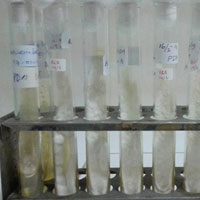Peningkatan Kemandirian Kelompok Petani Pengembang Agensia Hayati Dadi Makmur Untuk Memproduksi Aktivator Jamur Entomopatogen Beauveria bassiana Skala Rumah Tangga
DOI:
https://doi.org/10.14421/jbs.1410Keywords:
activator culture of biological agents, Beauveria bassiana, Dadi Makmur Farmer Communities on Biological Agents ProductionAbstract
Kelompok petani pengembang agensia hayati (KPPAH) Dadi Makmur merupakan salah satu kelompok tani di Kabupaten Sleman yang secara aktif menerapkan pengendalian biologis dengan memanfaatkan jamur entomopatogen Beauveria bassiana. Permasalahannya adalah produksi agensia hayati ini terkendala oleh ketersediaan kultur aktivator yang disuplai dari pihak lain. Oleh karena itu, diperlukan adanya kegiatan peningkatan kemandirian dalam bentuk pelatihan dan pendampingan terkait proses pembuatan aktivator B. bassiana menggunakan prosedur yang dapat diaplikasikan pada skala rumah tangga. Tujuan program ini untuk memperkenalkan prosedur produksi aktivator B. bassiana sehingga dapat meningkatkan pemahaman, kemampuan teknis dan kemandirian dari KPPAH ini. Tahapan kegiatannya meliputi pemetaan level pengetahuan dasar melalui aktivitas focus group discussion (FGD), pelatihan laboratorium dan pendampingan produksi aktivator B. bassiana di lokasi mitra. Hasil menunjukkan bahwa peningkatan kemandirian yang sangat signifikan dalam produksi aktivator (inokulum F2 dan F3) (100%), inkubasi inokulum F2 dan F3 (73,4%), dan mengamati karakteristik inokulum yang siap untuk diaplikasikan (75%). Ditinjau dari segi kemampuan teknis, anggota KPPAH Dadi Makmur menunjukkan tingkat kecakapan yang berbeda, terutama dalam kegiatan produksi inokulum F2 dan F3.
[Dadi Makmur is one of farmer communities in Sleman Regency that has applied the biological control actively and continously by utilizing the entomopathogenic fungus, Beauveria bassiana. The main problems found are this fungus production was constrained by the limited supply of activator culture from other party. Therefore, an independency improvement activity, in the form of training and supervision, is urgently needed, particularly related to the production of B. bassiana starter culture using an applicable method for home industry. This program was aimed to introduce the procedure used in the production of starter culture, thus it could improve the understanding, technical skill and the independency of this community. This activity consisted of several steps, such as mapping of basic understanding level through focus group discussion, laboratory training and on-site supervision of B. bassiana starter production. The results recorded a significant increase on people’s independency in the preparation of activator culture (F2 and F3) (100%), incubation of activator culture (73.4%) and characterization of a ready-to-apply inoculum (75%). Based on the technical skill, each member performed various levels of performance, particularly during the preparation of starter culture.]
References
Anonim. 2018. Nilaparvata lugens. https://www.cropscience.bayer.com/en/crop-compendium/pests-diseases-weeds/pests/nilaparvata-lugens. Diakses pada tanggal 21 November 2018.
Bottrell, D. G., and Schoenly, K. G. 2012. Resurrecting the ghost of green revolutions past: the brown planthopper as a recurring threat to high-yielding rice production in tropical Asia. Journal of Asia-Pacific Entomology 15:122-140.
Min, S., Lee, S. W., Choi, B.R., Lee, S. H., and Kwon, D. H. 2014. Insecticide resistance monitoring and correlation analysis to select appropriate insecticides against Nilaparvata lugens (Stål), a migratory pest in Korea. Journal of Asia-Pacific Entomology 17:711-716.
Nurani, A. R., Sudiarta, I. P., and Darmiati, N. N. 2018. Uji Efektifitas Jamur Beauveria bassiana Bals. terhadap Ulat Grayak (Spodoptera litura F.) pada Tanaman Tembakau. Journal of Tropical Agroecotechnology 7:11-23.

Downloads
Published
How to Cite
Issue
Section
License
Authors who publish with this journal agree to the following terms:
- Authors retain copyright and grant the journal right of first publication with the work simultaneously licensed under a Creative Commons Attribution-NonCommercial-ShareAlike 4.0 International (CC BY-NC-SA 4.0) that allows others to share the work with an acknowledgement of the work's authorship and initial publication in this journal.
- Authors are able to enter into separate, additional contractual arrangements for the non-exclusive distribution of the journal's published version of the work (e.g., post it to an institutional repository or publish it in a book), with an acknowledgement of its initial publication in this journal.
- Authors are permitted and encouraged to post their work online (e.g., in institutional repositories or on their website) prior to and during the submission process, as it can lead to productive exchanges, as well as earlier and greater citation of published work.





